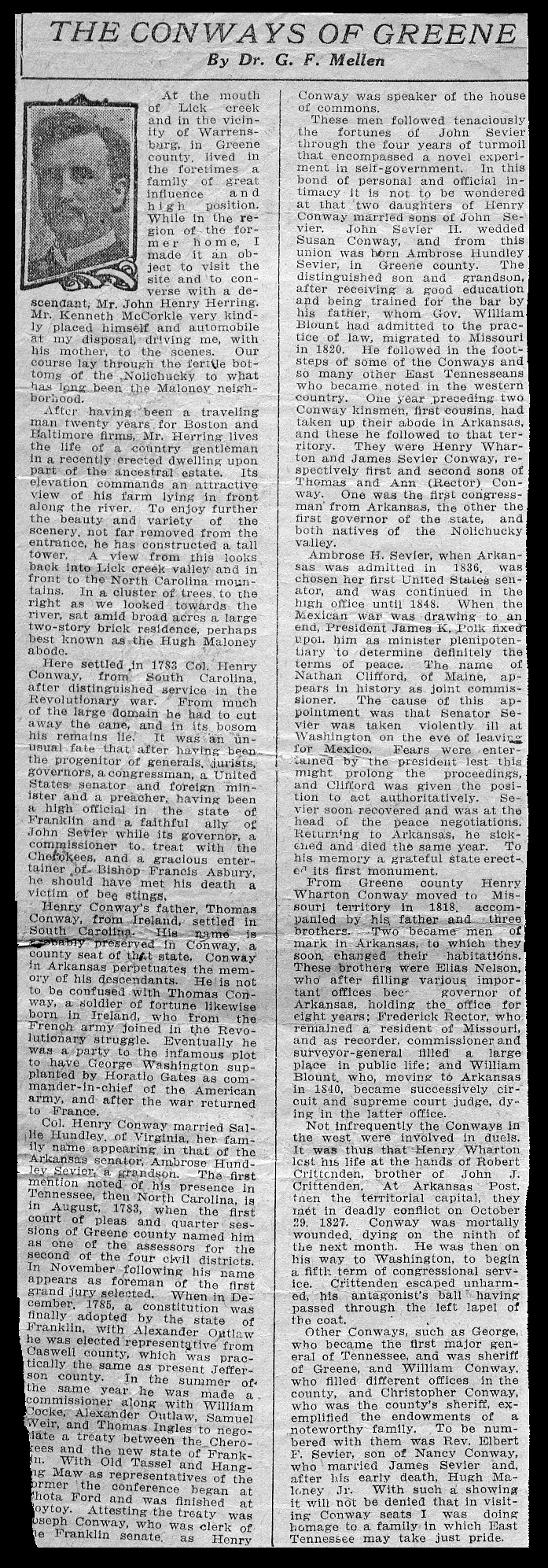"The Conway's of Greene" Article
(C. Avis Catalog entry #109)
<from unknown newspaper, unknown date -- The John Henry Herring mentioned has to be John Henry "Hal" Herring, Jr. (d. 1931)>
THE CONWAYS OF GREENE
By Dr. G. F. Mellen
At the mount of Lick creek and in the vicinity of Warrensburg, in Green county, lived in the foretimes a family of great influence and high position. While in the region of the former home, I made it an object to visit the site and to converse with a descendant, Mr. John Henry Herring. Mr. Kenneth McCorkle very kindly placed himself and automobile at my disposal, driving me, with his mother, to the scenes. Our course lay through the fertile bottoms of the Nolichucky to what has long been the Maloney neighborhood.
After having been a traveling man twenty years for Boston and Baltimore firms, Mr. Herring lives the life of a country gentleman in a recently erected dwelling upon part of the ancestral estate. Its elevation commands an attractive view of his farm lying in front along the river. To enjoy further scenery, not far removed from the entrance, he has constructed a tall tower. A view from this looks back into Lick creek valley and in front to the North Carolina mountains. In a cluster of trees to the right as we looked towards the river, sat amid broad acres a large two-story brick residence, perhaps best know as the Hugh Maloney abode.
Here settle in 1783 Col. Henry Conway, from South Carolina, after distinguished service in the Revolutionary war. From much of the large domain he had to cut away the cane, and in its bosom his remains lie. It was an unusual fate that after having been the progenitor of generals, jurists, governors, a congressman, a United States senator and foreign minister and a preacher, having been a high official in the state of Franklin and a faithful ally of John Sevier while its governor, a commissioner to treat with the Cherokees, and a gracious entertainer of Bishop Francis Asbury, he should have met his death a victim of bee stings.
Henry Conway's father, Thomas Conway, from Ireland, settled in South Carolina. His name is probably preserved in Conway, a county seat of that state. Conway in Arkansas perpetuates the memory of his descendants. He is not to be confused with Thomas Conway, a soldier of fortune likewise born in Ireland, who from the French army joined in the Revolutionary struggle. Eventually he was a party to the infamous plot to have George Washington supplanted by Horatio Gates as commander-in-chief of the American army, and after the war returned to France.
Col. Henry Conway married Sallie Hundley, of Virginia, her family name appearing in that of the Arkansas senator, Ambrose Hundley Sevier, a grandson. The first mention noted of his presence in Tennessee, then North Carolina, is in August, 1783, when the first court of pleas and quarter sessions of Greene county named him as one of the assessors for the second of the four civil districts. In November following his name appears as foreman of the first grand jury selected. When in December, 1785, a constitution was finally adopted by the state of Franklin, with Alexander Outlaw he was elected representative from Caswell county, which was practically the same as present Jefferson county. In the summer of the same year he was made a commissioner along with William Cocke, Alexander Outlaw, Samuel Weir, and Thomas Ingles to negotiate a treaty between the Cherokees and the new state of Franklin. With Old Tassel and Hanging Maw as representatives of the former the conference began at _hota Ford and was finished at _oytoy. Attesting the treaty was Joseph Conway, who was clerk of the Franklin senate, as Henry Conway was speaker of the house of commons.
These men ___ ved tenaciously the fortunes of John Sevier through the four years of turmoil that encompassed a novel experiment in self-government. In this bond of personal and official intimacy it is not to be wondered at that two daughters of Henry Conway married sons of John Sevier. John Sevier II. wedded Susan Conway, and from this union was born Ambrose Hundley Sevier, in Greene county. The distinguished son and grandson, after receiving a good education and being trained for the bar by his father, whom Gov. William Blount had admitted to the practice of law, migrated to Missouri in 1820. He followed in the footsteps of some of the Conways and so many other East Tennesseans who became noted in the western country. One year preceding two Conway kinsmen, first cousins, had taken up their abode in Arkansos, and these he followed to that territory. They were Henry Wharton and James Sevier Conway, respectively first and second sons of Thomas and Ann (Rector) Conway. One was the first congressman from Arkansas, the other the first governor of the state, and both natives of the Nolichucky valley.
Ambrose H. Sevier, when Arkansas was admitted in 1836, was chosen her first United States senator, and was continued in the high office until 1848. When the Mexican war was drawing to an end, President James K. Polk fixed upon him as minister plenipotentiary to determine definitely the terms of peace. The name of Nathan Clifford, of Maine, appears in history as joint commissioner. The cause of this appointment was that Senator Sevier was taken violently ill at Washington on the eve of leaving for Mexico. Fears were entertained by the president lest this might prolong the proceedings, and Clifford was given the position to act authoriatatively. Sevier soon recovered and was at the head of the peace negotiations. Returning to Arkansas, he sickened and died the same year. To his memory a grateful state erected its first monument.
From Greene county Henry Wharton Conway moved to Missouri territory in 1818, accompanied by his father and three brothers. Two became men of mark in Arkansas, to which they soon changed their habitations. These brothers were Elias Nelson, who after filling various important offices became governor or Arkansas, holding the office for eight years; Frederick Rector, who remained a resident of Missouri, and as recorder, commissioner and surveyor-general filled a large place in public life; and William Blount, who, moving to Arkansas in 1840, became successively circuit and supreme court judge, dying in the latter office.
Not infrequently the Conways in the west were involved in duels. It was thus that Henry Wharton lost his life at the hands of Robert Crittenden, brother of John J. Crittenden. At Arkansas Post, then the territorial capital, they met in deadly conflict of October 29, 1827. Conway was mortally wounded, dying on the ninth of the next month. He was then on his way to Washington, to begin a fifth term of congressional service. Crittenden escaped unharmed, his antagonist's ball having passed through the left lapel of the coat.
Other Conways, such as George, who became the first major general of Tennessee, and was sheriff of Greene, and William Conway, who filled different offices in the county, and Christopher Conway, who was the county's sheriff, exemplified the endowments of a noteworthy family. To be numbered with them was Rev. Elbert F. Sevier, son of Nancy Conway, who married James Sevier and after his early death, Hugh Moaloney Jr. With such a showing it will not be denied that in visiting Conway seats I was doing homage to a family in which East Tennessee may take just pride.
Image

Source Description
Article about Conway family (in-laws of Seviers)
Description/Transcription
